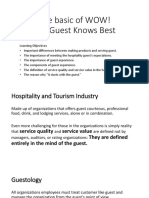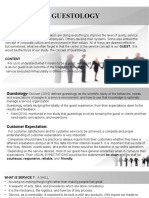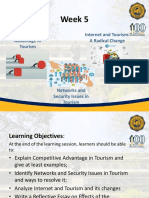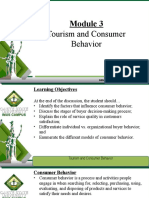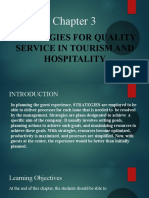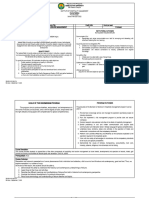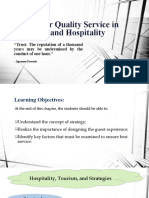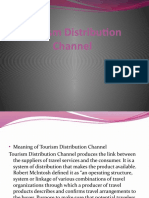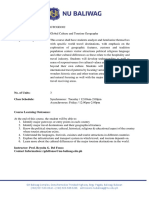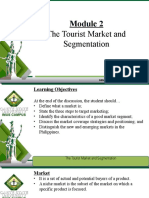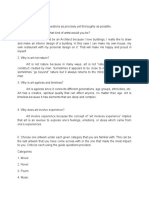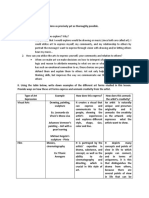100%(1)100% found this document useful (1 vote)
510 views21 pagesGuest Ology
This document discusses the concept of guestology. [1] Guestology is defined as the scientific study of guest behaviors, needs, and expectations in a service environment and how to optimally manage based on this knowledge. [2] There are different types of guests with varying expectations, including loyal, impulse, discount-seeking, need-based, and wandering guests. [3] Ultimately, the customer defines value and quality based on whether their expectations were met or exceeded by their experience.
Uploaded by
Ace Shernyll Son GallanoCopyright
© © All Rights Reserved
Available Formats
Download as PPTX, PDF, TXT or read online on Scribd
Download as pptx, pdf, or txt
100%(1)100% found this document useful (1 vote)
510 views21 pagesGuest Ology
This document discusses the concept of guestology. [1] Guestology is defined as the scientific study of guest behaviors, needs, and expectations in a service environment and how to optimally manage based on this knowledge. [2] There are different types of guests with varying expectations, including loyal, impulse, discount-seeking, need-based, and wandering guests. [3] Ultimately, the customer defines value and quality based on whether their expectations were met or exceeded by their experience.
Uploaded by
Ace Shernyll Son GallanoCopyright
© © All Rights Reserved
Available Formats
Download as PPTX, PDF, TXT or read online on Scribd
Download as pptx, pdf, or txt
Download as pptx, pdf, or txt
You are on page 1/ 21
GUESTOLOGY
CHAPTER 2
Introduction
• Many establishment and organizations are doing
everything to improve the level of quality service through
the performance of the employees. Others develop their
system.
• Some also embed the concept of corporate culture and
environment in their setups.
• All of these are deemed effective, but sometimes, what we
often forget is that the center of the service concept is our
guests.
• This would focus of our study, the concept of Guestology.
Learning Objectives
At the end of this chapter, the students should be able to:
• Define what guestology is and what a guestology is;
• Determine the predictors of costumer expectation;
• Identify the different types of costumers; and
• Determine who defines value and quality.
Content
• For us to understand what it means to be a guest, we should now
understand what hospitality is our guest is an outcome of the
hospitality that we give.
• Service executed immaculately is different from hospitality.
• Service providers today are focusing on making things right rather
than making people feel great.
• Service is the sequence of acts, tasks, and procedures which are
done with consistency.
Guestology
• Dickson (2010) defined guestology as
the scientific study of the behaviors,
needs, and expectations of people in
service environment, and how to use
that knowledge to optimally manage
a service organization.
• The concept that Bruce Laval, the
father of guestology, introduced has
now become a science that ideals
with understanding the guest.
• Klien (2014) mentioned in her
study that guestology involves
knowing the guest or clients and
their needs and want,
perceptions, and expectations.
• As tricky as it is, identifying the
actual needs and wants,
perceptions, and expectation
well really seal the deal.
Customer Expectations
• For customer satisfaction service to be
achieved, a complete and proper
understanding of costumer expectation
is very important.
• A guest who will dine in a restaurant for
the first time will have a different
expectation than a guest who has been
in the restaurant for a couple of times.
• The expectations of a frequent flier for
business purposes may also have a
different expectation with that of family
on a trip to another country.
Restaurant Survey Form
• Planning for costumer satisfaction
is really important in this case as
this will be the platform for the
design of the experience.
• much more in the Philippine
culture, where there are
different sets of beliefs and
ideals; there are also different
sets of expectation.
• Establishments geared toward delivery
of services in tourism and hospitality
should always be careful not to over
deliver the said services.
• If a guest were to enter fast-food
restaurant which tables lined with
expensive linen, he/she would be
expecting the levels of casual or fine
dining restaurant.
• Food attendants or waiter should
literally “wait” for their guest when
dining in a restaurant.
• Anticipating guest needs is one of the
primary responsibilities of a waiter
and that he/she should be good at it.
It requires full of attention so that
whenever a guest’s need something,
he/she could immediately handle the
concern and attend to the guest’s
request.
• Ekiz et al. (2012) noted in their
article that even in luxury hotels,
there are still basic problems that
are actually unresolved, and with
social media around, guest have
easy access to flaunt these
problems which sets a springboard
for other problems.
They enumerated a number of problems in
their article which are the following:
1. Rooms – with concerns extending from small sized rooms to rooms with no modern
technology.
2. Arrogant and/or clueless staff – with comments ranging from staff being rude and no
answer to questions posed.
3. Failure to respond – many covering staff’s failure to respond to guest complaints
4. Poor delivery – covering complaints such as late service or wrong room service and
long process for check-in/outs
5. Cleanliness – with criticism on soiled-linen, carpets stains, and hair trapped in
bathtubs.
6. Amenities and utilities – with problem of associated to the lack or inadequacy of
toilets and items in minibar
7. Billing – with guest grumbling about having them charged extra for parking, Internet,
Costumers/Guest/Clients
• Costumers, otherwise known as guests and clients, in the
hospitality and tourism business play a significant role in
the operation. To understand their behavior and to
strategize the efforts of the company, it is important to
identify and match each need to each type of costumer.
The Corporate Finance Institute (2015) has identified five basic types of customers
that a hospitality and tourism enterprise should be aware of. They are:
1. The loyal customers are actually the most important segment to please and
should be one of the priorities in mind of a specific company.
2. Impulse customers, meanwhile, are the best type to do suggestive selling. They
are also second to loyal customers when it comes to attractiveness in the
market.
3. Another type of customer which affects a company’s inventory turnover is the
discount customer. They are contributory to a company’s cash flow because the
products which are seldom purchased at full price are actually availed by these
customers as the best markdowns.
4. The fourth type of customers is driven by a specific need. These
customers are called the need-based customers. They buy for a
specific reason and occasion, because of this.
5. The last type of customers is the wandering customers. These
customers generate the largest amount of traffic as they have no
specific need or desire in mind but yield the smallest percentage
in sales revenue.
• Identifying these segment is significant as the
generate revenue for the enterprise. Alongside
these segments drag another type of customer
that is usually forgotten or left out. It is call
internal customers.
Quality and Value
• In the previous chapter; quality was defined individually.
Here we will view the quality as tied together to the
concept of value and how affects the guest-service staff
relationship.
• The measure of quality for the guest is actually based on
the difference between their expectation and their
experience (or as netizens quote it in present memes,
“reality”). By reality, it means what the guest have
experienced in actual sense.
• Lugaw, one of the foods offered
in an unlimited concept, catering
to people who want cheap but
high quality food-because of its
ingredients.
• Value, in relation to quality would entail the study of costs. To
measure the value derived from a guest experience, we need
to match if the costs incurred total or equal to the quality of
the experience.
The Costumer and the Definition of Value
• Since the tourism and hospitality
industry is a guest-centered or
costumer-centered industry, ultimately,
it is the costumer who defines value.
• The output will be the ultimate measure
whether a service design has been
crafted excellently.
You might also like
- Chapter 5 Various Roles of A Tour GuideNo ratings yetChapter 5 Various Roles of A Tour Guide21 pages
- Module 1. Intro To Tourism and Hospitality (Quality Service in T & H) - THCC 216100% (1)Module 1. Intro To Tourism and Hospitality (Quality Service in T & H) - THCC 2166 pages
- Week 5 - Competitive Advantage in TourismNo ratings yetWeek 5 - Competitive Advantage in Tourism17 pages
- Module 2. (Quality Service Management) - THCC 216No ratings yetModule 2. (Quality Service Management) - THCC 21610 pages
- Introduction To Quality Service Management in Tourism and HospitalityNo ratings yetIntroduction To Quality Service Management in Tourism and Hospitality10 pages
- Historical Perspective of Travels and Tours L2100% (1)Historical Perspective of Travels and Tours L24 pages
- Module 3. Tourism and Consumer BehaviorNo ratings yetModule 3. Tourism and Consumer Behavior14 pages
- Bme 1 Operation Management in Tourism Hospitality Industry: Carmelita Paguyo - SerranoNo ratings yetBme 1 Operation Management in Tourism Hospitality Industry: Carmelita Paguyo - Serrano64 pages
- Travel Writing and Photography Prelim Term Examination and Performance TaskNo ratings yetTravel Writing and Photography Prelim Term Examination and Performance Task2 pages
- Chapter 3 - Strategies For Quality Service in Tourism and HospitalityNo ratings yetChapter 3 - Strategies For Quality Service in Tourism and Hospitality22 pages
- The Meaning and Characteristics of Tourism and Hospitality IndustryNo ratings yetThe Meaning and Characteristics of Tourism and Hospitality Industry23 pages
- HM F Elec 12 Recreation and Leisure ManagementNo ratings yetHM F Elec 12 Recreation and Leisure Management7 pages
- Chapter 2 Tourism and Hospitality MarketingNo ratings yetChapter 2 Tourism and Hospitality Marketing44 pages
- Chapter 3 Strategies For Quality Service in Tourism and HospitalityNo ratings yetChapter 3 Strategies For Quality Service in Tourism and Hospitality11 pages
- HM - THC 4 Phil. Culture, and Tourism GeographyNo ratings yetHM - THC 4 Phil. Culture, and Tourism Geography26 pages
- Week 2 - Module 1 Concepts of Tourism and Hospitality100% (1)Week 2 - Module 1 Concepts of Tourism and Hospitality6 pages
- Preliminary Exam in Travel and Tour ManagementNo ratings yetPreliminary Exam in Travel and Tour Management4 pages
- Program Educational Objectives Mission: Principles of Tourism 1 and Principles of Tourism IiNo ratings yetProgram Educational Objectives Mission: Principles of Tourism 1 and Principles of Tourism Ii8 pages
- Micro Perspective of Tourism and Hospitality HandoutsNo ratings yetMicro Perspective of Tourism and Hospitality Handouts6 pages
- Quality Service Management in Tourism and Hospitality SyllabusNo ratings yetQuality Service Management in Tourism and Hospitality Syllabus5 pages
- Applied Business Tools and TechnologiesNo ratings yetApplied Business Tools and Technologies12 pages
- Information Technology Applications (GDS) in Tourism and Hospitality IndustryNo ratings yetInformation Technology Applications (GDS) in Tourism and Hospitality Industry56 pages
- Unit 1 The Meaning and Importance of Tourism and HospitalityNo ratings yetUnit 1 The Meaning and Importance of Tourism and Hospitality4 pages
- Chapter 4 - Developing The Hospitality CultureNo ratings yetChapter 4 - Developing The Hospitality Culture33 pages
- Chapter 7-The Toruism and Network SupplyNo ratings yetChapter 7-The Toruism and Network Supply10 pages
- Ch. 8 - Micro Perspective of The Tourism and HospitalityNo ratings yetCh. 8 - Micro Perspective of The Tourism and Hospitality22 pages
- TPC 6 Tour and Travel Management. Chapter 1-2No ratings yetTPC 6 Tour and Travel Management. Chapter 1-270 pages
- Module 2. The Tourist Market and SegmentationNo ratings yetModule 2. The Tourist Market and Segmentation19 pages
- The Psychology of Travel.6704938.PowerpointNo ratings yetThe Psychology of Travel.6704938.Powerpoint28 pages
- chapter 2 - quality service - guestologyNo ratings yetchapter 2 - quality service - guestology40 pages
- Module 1. Intro To Tourism and Hospitality (Quality Service in T & H) - THCC 216Module 1. Intro To Tourism and Hospitality (Quality Service in T & H) - THCC 216
- Introduction To Quality Service Management in Tourism and HospitalityIntroduction To Quality Service Management in Tourism and Hospitality
- Bme 1 Operation Management in Tourism Hospitality Industry: Carmelita Paguyo - SerranoBme 1 Operation Management in Tourism Hospitality Industry: Carmelita Paguyo - Serrano
- Travel Writing and Photography Prelim Term Examination and Performance TaskTravel Writing and Photography Prelim Term Examination and Performance Task
- Chapter 3 - Strategies For Quality Service in Tourism and HospitalityChapter 3 - Strategies For Quality Service in Tourism and Hospitality
- The Meaning and Characteristics of Tourism and Hospitality IndustryThe Meaning and Characteristics of Tourism and Hospitality Industry
- Chapter 3 Strategies For Quality Service in Tourism and HospitalityChapter 3 Strategies For Quality Service in Tourism and Hospitality
- Week 2 - Module 1 Concepts of Tourism and HospitalityWeek 2 - Module 1 Concepts of Tourism and Hospitality
- Program Educational Objectives Mission: Principles of Tourism 1 and Principles of Tourism IiProgram Educational Objectives Mission: Principles of Tourism 1 and Principles of Tourism Ii
- Micro Perspective of Tourism and Hospitality HandoutsMicro Perspective of Tourism and Hospitality Handouts
- Quality Service Management in Tourism and Hospitality SyllabusQuality Service Management in Tourism and Hospitality Syllabus
- Information Technology Applications (GDS) in Tourism and Hospitality IndustryInformation Technology Applications (GDS) in Tourism and Hospitality Industry
- Unit 1 The Meaning and Importance of Tourism and HospitalityUnit 1 The Meaning and Importance of Tourism and Hospitality
- Ch. 8 - Micro Perspective of The Tourism and HospitalityCh. 8 - Micro Perspective of The Tourism and Hospitality





